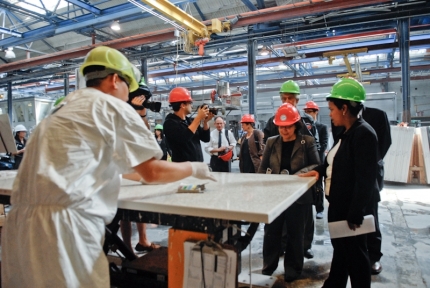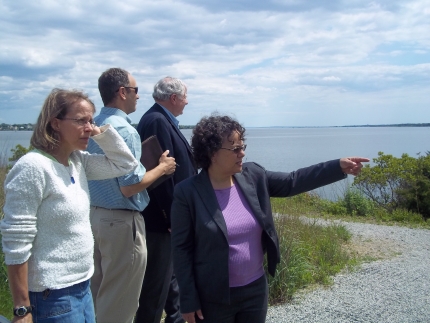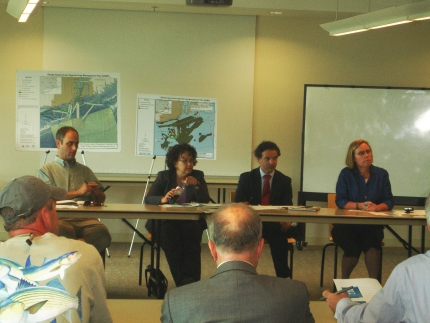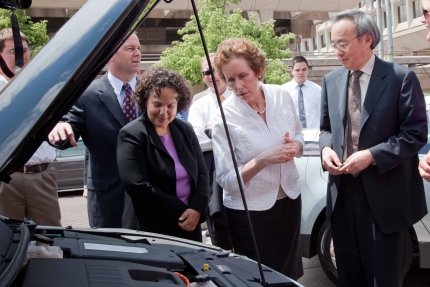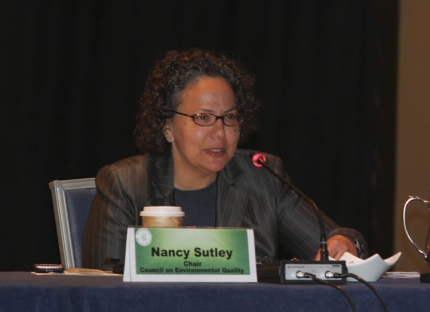Council on Environmental Quality Blog
Manufacturing Our Nation's Clean Energy Future
Posted by on June 20, 2011 at 1:00 PM EDTThroughout America, even in this difficult economic environment, there are examples of innovation and entrepreneurship that inspire us with their creativity and success. I came across one of these places recently at the Brooklyn Navy Yard in not surprisingly, Brooklyn New York, a former shipyard that is now a thriving urban industrial park. There, a small manufacturer named IceStone has capitalized on the demand for safe and sustainable products by creating countertops and surfaces from 100 percent recycled glass, diverting hundreds of tons of glass from landfills each year. In doing so, they've created more than 40 good jobs in a daylit facility and sustainable work environment that their workers feel good about.
As a New York native myself, I remember what the Brooklyn Navy Yard used to look like when I was growing up – a bleak space that was not an obvious boon to the community. Today, it is transformed – it's a thriving place in a vibrant community. With Federal, State and local support, it is an innovation hub, and a unique urban haven for small green manufacturers. In addition to Icestone, this includes companies like Duggal, which has designed and manufactured a wind-solar street lamp, and SMIT, which is designing an ivy-inspired wind and solar energy system that can be draped over the sides of a building. To support homegrown jobs and manufacturers like these, the Brooklyn Navy Yard has 12 new green industrial buildings in design or construction, and is adding 2 million square feet of space over next two years.
President Obama has launched a plan to spark manufacturing growth and new jobs for American families. The Navy Yard is a great example of the growth of small green manufacturing across industrial sectors, and it's a model that can be replicated in other urban centers for how to grow a city's economy, grow good middle class jobs, and build a more sustainable city. Manufacturing remains one of America's most globally competitive economic sectors, and even amid the biggest recession since the Great Depression, we are seeing this sector bounce back. My time at the Brooklyn Navy Yard gave me a valuable opportunity to engage in a conversation about how the Federal Government can better support small manufacturers that provide good middle-class jobs in their communities. We will keep engaging in these types of conversations and following them up with action to ensure we are investing in the spark and ingenuity of our entrepreneurs, good American jobs, and a strong foundation for the American economy in the 21st century.
Besides all this, I got to be an honorary Brooklynite for the day!
Nancy Sutley is Chair of the White House Council on Environmental Quality
Learn more about Energy and EnvironmentOcean Stewardship Built By You, For You
Posted by on June 8, 2011 at 7:04 PM EDTOur nation's coastal areas provide a wealth of natural and economic resources, and generate tens of millions of jobs and trillions of dollars for our economy each year. More than half of our country's population calls the coastal fringe that borders our nation home. However, competing uses and demands on the ocean threaten the health of our oceans, coasts, and Great Lakes. President Obama established the National Ocean Council to develop and implement a new, comprehensive ocean stewardship policy built with input from the American people.
June marks National Oceans Month, and the National Ocean Council is holding a series of events all month to hear from the communities that depend on our oceans and coasts about the actions they would like to see put in place to implement this policy.
This week, Senator Reed invited me to Providence, Rhode Island, where I heard a wide range of perspectives on the importance of collaborative ocean planning efforts to build a successful policy that addresses the diversity of coastal regions and uses of the ocean. I heard about ways in which Federal actions and resources under the new National Ocean Policy can help Rhode Island continue building on local efforts and success. It was clear that the diverse collection of participants, state and tribal authorities, users, stakeholders, and partners, including Senator Whitehouse, who participated in the State process, had pride in their recently completed State ocean plan. Sen. Whitehouse has taken the lessons from what the State of Rhode Island has done and is working in the Senate to protect our oceans.
The feedback and discussions we will gather throughout the month will ensure that this Administration is implementing a robust, smart and scientific ocean policy that will address the most critical issues facing our nation’s waters. As we work to better harmonize and sustain the uses and health of our oceans, coasts, and the Great Lakes, we want to hear from you to put into action a plan built with you for you.
Nancy Sutley is Chair of the White House Council on Environmental Quality
Learn more about Energy and EnvironmentTommy Allred Meets the President
Posted by on May 27, 2011 at 1:00 PM EDTEditor's Note: This blog introduces readers to Alexandra Allred, the mother of 11-year old Tommy Allred who suffers from chronic asthma. The Allreds live in a city with poor air quality polluted by local cement plants, which affects Tommy's asthma. Read about their journey to Washington, DC and how the Obama Administration is working to protect future generations by putting in place standards that will ensure clean, healthy air for all Americans.
Early in his term, President Obama's Environmental Protection Agency (EPA) finalized an important health-protective standard that cleans up the smokestacks of cement plants, among other things, to better protect my son! This is very important to us as we live in Midlothian, Texas, the "Cement Capital of Texas," where three cement plants spew dangerous pollutants that can trigger asthma attacks, cause neurological damage, destroy organs, damage the nervous system and much more.
If you read my son Tommy's book, How I Met the President, you will learn that he developed chronic asthma from breathing toxins in the air from our local cement plants, and as a result, met the President. While our experiences did not unfold that simply, as Tommy likes to say, "That was how we met President Obama!"
My son's elementary school was recently identified by USA Today as one of the most toxic elementary schools in the United States. In fact, in 2004, nearly 800,000 lbs of various kinds of toxic pollution were released into Midlothian's air, land, and water, including over 1,000 lbs of mercury, 119,000 lbs of lead, 58,000 lbs of benzene, 89,000 lbs of toluene, and 600 lbs each of styrene and naphthalene. Once we learned what was being released by our local plant smokestacks, the rare cancers, birth defects, and upper respiratory diseases that plague our town began to make sense. In the meantime, our Texas politicians demonstrated little to no concern.
In protest, my family and I traveled to Washington D.C. in 2007 to speak with Texan Senators and Representatives but were ignored by our Congressional members. We had a 10:00 a.m. confirmed appointment with legislative staff, and were instead forced into the hallway to speak with an intern. As we stood disheartened in the hallways of Congress, the unexpected happened: We were invited to a "meet and greet" with then Senator Obama. A Senator all the way from Illinois was actually willing to meet with us about our air quality in Texas! It was at that session that Tommy had the opportunity to meet and speak with our future President about his struggles living with asthma. Then-Senator Obama even shared with Tommy that his own daughter had asthma. Somebody was listening! Somebody cared!
As the daughter of a retired Army colonel and Vietnam veteran, I have seen how wonderful our country can be. I do not understand how any American can question, let alone undermine, the efforts of their fellow citizens to keep our air pure and clean, keep our citizens safe and healthy. This was not just a fight about my son’s health or that of other children. This had become a fight about doing what is right, and Tommy has also taken a stand by writing his book titled, How I Met The President.
It is a book about protecting and defending our rights as Americans and Tommy is a great little American who still struggles to breathe. But he stood up for millions of other Americans who are also suffering from asthma. And on May 2, 2011, I returned to Washington D.C., but this time, was joined by more than 80 Clean Air Ambassadors from all 50 states and Puerto Rico, and members from Earthjustice.
Right now, most Americans are worried about the economy, but what often is left out of the economic picture presented is the money saved by setting standards that protect public health. For example, if the EPA required industrial power plants to clean up their pollution, it would save this country up to $50 billion in medical costs. While saving money, we'd also be protecting the public, saving as many as 6,500 lives and avoiding 41,000 asthma attacks every year. My son and thousands of children just like him would have cleaner air to breathe and a healthier future.
We appreciate all that the Obama Administration has done thus far to protect public health. There is much hard work that remains to be done ranging from establishing a health-protective ozone standard to finally cleaning up coal ash dumps. For the sake of our country, we hope more politicians will be motivated by the principles upon which this country was founded rather than corporate interests. It may not be easy, but even Tommy knows that standing up for what you know is right will yield results. In the words of this administration, "Yes, we can!"
Alexandra Allred is from Midlothian, Texas
Driving our Nation Toward America's Clean Energy Future
Posted by on May 24, 2011 at 7:40 PM EDTToday, U.S. Department of Energy Secretary Steven Chu, U.S. General Services Administrator Martha Johnson and White House Council on Environmental Quality Chair Nancy Sutley came together to announce another major step in leading by example and reducing our dependence on oil by boosting clean energy technologies in our Federal fleet. President Obama today issued a Presidential Memorandum that will implement new Federal fleet management practices to further the Administration's goals to cut oil imports by one-third by 2025 and to put one million advanced vehicles on the road by 2015. In tandem, building on the doubling of the Federal hybrid fleet last year, GSA launched a historic Electric Vehicle Pilot program that will put the President’s plan into action and place alternative fueled vehicles into cities across the country.
Check out the video below to watch Secretary Chu, Administrator Johnson, and Chair Sutley announce the President's Memorandum and launch the government's first Electric Vehicle Pilot program:
The response has already been overwhelmingly positive. See some statements of support below from various business leaders, advocacy groups and Members of Congress:Brian Wynne, President, the Electric Drive Transportation Association
"The Electric Drive Transportation Association (EDTA) applauds the vital work being done in bringing electric drive vehicles to federal fleets. Their commitment will help accelerate private sector investment in the advanced technologies that will fuel our sustainable transportation future."Greg Martin, Director of Policy and Washington Communications, General Motors
"Electric vehicles represent a leap forward toward a more clean and secure America. The technology that powers electric vehicles is essential to building our Nation's long term, global competitive strength and lessening our dependence on foreign energy sources. The federal fleet provides a good proving ground for these advanced vehicles and can help spur greater market interest. In this regard, the GSA Pilot program is leading the way."Joe Mendelson, Director of Policy, Climate & Energy Program, National Wildlife Federation
"Jump starting the electrification of our federal fleet is a great deal for taxpayers and the environment. It leads the way toward a future that avoids high prices at the gas pump, reduces carbon pollution, and invests in made-in-America technology."Lizabeth Ardisana, Director of Sales, Service and Distribution, THINK
"Government involvement is critical to support and sustain the growing U.S. EV industry and direct government purchases of electric vehicles is the next logical step in supporting the policy to reduce America’s reliance on imported petroleum by one-third," said Lizabeth Ardisana, THINK Director of Sales, Service and Distribution. "Additionally, the loans and grants that manufacturers and local governments have received to support the commercialization of EV technology and related infrastructure have laid the groundwork to create a wealth of new job opportunities in the U.S."Senator Tom Carper, U.S. Senator for Delaware
"The price at the gas pump is putting a big dent in the pocketbooks of millions of families and businesses across our nation. The impact of high gas prices on the federal government's fuel bill is no different. The hundreds of thousands of vehicles in the federal government's fleet cost taxpayers millions in fuel costs every year, at a time when the federal government is trying to get the most out of every dollar we spend. High fuel costs present yet another significant challenge for the federal government as we work to curb federal spending, but as Albert Einstein once said 'in adversity lies opportunity,' and this challenge certainly provides an opportunity for the federal government to rethink how we fuel our vehicle fleet."President Obama's memorandum and the General Services Administration's announcement on new government-wide fleet management practices is a welcome step in the right direction to cut those significant vehicle fuel costs and help strengthen the American economy. It also comes on the heels of the release of a recent Government Accountability Office report that detailed how federal agencies are struggling with some of the vehicle mandates that have been placed on them. Moving to alternative fuel vehicles will help us reach the President's goal of a 30 percent reduction in petroleum use by 2015. This action underscores the Obama Administration's willingness to lead the way in increasing energy efficiency, and it will also allow us to leverage the enormous buying power of the federal government to make these vehicles more affordable for every American family and business. I am also encouraged that as part of this effort, the President is asking agencies to figure out their optimal fleet size and composition. Given the enormous budget deficits we face, we need to take a harder look at every dollar we spend to determine that it is both essential and as cost-effective an expenditure as possible. My subcommittee plans on following up with agencies about their work to determine their fleet's size and cost in the coming months."
Mindy Lubber, President, Ceres
"Today's announcement to clean up the federal fleet and invest in our advanced vehicle industry isn't just smart government and environmental policy, it's good economic policy," said Mindy Lubber, President of the nationwide business and investor coalition Ceres. "America needs to lead in clean transportation. Government action like this shows that we can in fact achieve our clean energy goals, even as it primes the pump for key American industries to grab a competitive edge."Roy Durham, Corp. /Govt. Fleet Director, RP Automotive
"RP Automotive is honored to be working with the GSA in their role to provide alternative fuel vehicles to the federal fleet in an effort to reduce both petroleum usage and harmful greenhouse gasses. We are proud to be a part of our government's plans to utilize zero and near-zero emission vehicles that will have measurable and positive effects for all of us."Leaders of the Sustainable Energy & Environment Coalition, U.S. House of Representatives
The Sustainable Energy & Environment Coalition is co-chaired by Reps. Jay Inslee (D-WA) and Steve Israel (D-NY).
"The Sustainable Energy & Environment Coalition commends the Obama Administration and all participating federal agencies for their efforts to deploy electric and alternative fuel vehicles. As the operator of the nation’s largest vehicle fleet, the federal government's purchasing power can drive the widespread adoption of these vehicles, which will reduce America’s oil addiction and fuel costs, and decrease greenhouse gas and other air pollution, all the while growing American jobs and our economy by increasing domestic production of the vehicles of the twenty-first century."Just as importantly, the Electric Vehicle Pilot Program and related efforts will save Americans money in two different ways: By reducing the federal government’s fuel costs – a direct saving for taxpayers that promises to grow with the success of this program; and by reducing America’s oil demand, which is one of the chief drivers of climbing gasoline prices. SEEC commends the Obama Administration for its continued work to break the oil addiction that is so costly to Americans and jeopardizes our national security."
Sahar Wali is the Director of Communications at the White House Council on Environmental Quality
Learn more about Energy and EnvironmentWorking with Communities to Restore a Healthy and Prosperous Gulf Coast
Posted by on May 12, 2011 at 6:00 PM EDTJust a year ago our nation was dealt a harsh reminder of the connection between the health of our economy and the health of our environment. Millions of residents across the Gulf Coast suffered impacts to their daily lives and livelihoods caused by the environmental devastation resulting from the Deepwater Horizon oil spill. The spill intensified the decades-long decline of the Gulf's rich and valuable coastal ecosystems upon which these economies depend. Since taking office, this Administration has been working to protect and restore this natural treasure.
By putting in place smarter and stronger standards of safety and responsibility for deepwater drilling, we're working to protect our natural resources from this kind of catastrophic damage. These higher standards will promote safe and responsible offshore oil exploration and production, while reducing our country's reliance on foreign oil, creating jobs for the American people, and ensuring our nation’s energy security.
The President also established the Gulf Coast Ecosystem Restoration Task Force, which includes representatives from Federal agencies and the Gulf Coast states, to coordinate the long-term restoration effort based on input from local scientists, experts, and citizens. He made clear that restoration priorities should be set by the Gulf region for Washington, and not the other way around. At a Task Force meeting last week in Mobile, Alabama, EPA Administrator Lisa Jackson launched a citizens' advisory committee to provide residents and local organizations a more effective way to voice their environmental concerns to help guide restoration efforts. Key priorities, developed with input from the public and key stakeholder groups throughout the region, for the ongoing restoration of the Gulf include enhancing community resilience and restoring important coastal habitats.
Visiting the Gulf always reinforces for me the tremendous value of the coastal ecosystems to the economies and livelihood of our nation. The Gulf is the heartbeat of the region's economy, and a lifeline to the economy of the United States. The region handles more water-borne commerce than any other place in the country, and is home to the largest commercial fishery in the contiguous United States. It is also a tourism powerhouse, and helps shape the many unique cultures of the communities in that part of the country. And of course, the bayous, barrier islands, bays and estuaries that dominate the region provide critical protections to communities that are devastatingly vulnerable to hurricanes.
We will continue to bring together Federal agencies, states, and local communities to ensure a smart, forward-looking, and comprehensive restoration strategy that responds to the priorities of Gulf residents. We are committed to bringing the Gulf back better than it was before, and to restoring the coast in ways that enhance the livelihood and quality of life for our communities and for our economy.
Nancy Sutley is Chair of the White House Council on Environmental Quality
Learn more about Energy and EnvironmentKnowing Where We Stand to Save Money, Improve Efficiency, Reduce Pollution, and Eliminate Waste
Posted by on April 28, 2011 at 12:00 PM EDTLast week, Federal agencies released, for the first time, their scorecards on energy and environmental performance. This marked an important milestone towards achieving the President's sustainability goals under Executive Order 13514 on Federal Leadership in Environmental, Energy and Economic Performance. By establishing benchmarks, these scorecards help guide agencies' 2011 sustainability plans to save energy, improve the environment, and save money. Today, we mark the next milestone in this process by releasing the first-ever comprehensive Greenhouse Gas (GHG) Emissions Inventory for the Federal Government, which accounts for the GHG emissions associated with the Federal Government’s operations in 2010.
Learn more about Energy and Environment
- &lsaquo previous
- …
- 24
- 25
- 26
- 27
- 28
- 29
- 30
- 31
- 32
- …
- next &rsaquo
White House Blogs
- The White House Blog
- Middle Class Task Force
- Council of Economic Advisers
- Council on Environmental Quality
- Council on Women and Girls
- Office of Intergovernmental Affairs
- Office of Management and Budget
- Office of Public Engagement
- Office of Science & Tech Policy
- Office of Urban Affairs
- Open Government
- Faith and Neighborhood Partnerships
- Social Innovation and Civic Participation
- US Trade Representative
- Office National Drug Control Policy
categories
- AIDS Policy
- Alaska
- Blueprint for an America Built to Last
- Budget
- Civil Rights
- Defense
- Disabilities
- Economy
- Education
- Energy and Environment
- Equal Pay
- Ethics
- Faith Based
- Fiscal Responsibility
- Foreign Policy
- Grab Bag
- Health Care
- Homeland Security
- Immigration
- Innovation Fellows
- Inside the White House
- Middle Class Security
- Open Government
- Poverty
- Rural
- Seniors and Social Security
- Service
- Social Innovation
- State of the Union
- Taxes
- Technology
- Urban Policy
- Veterans
- Violence Prevention
- White House Internships
- Women
- Working Families
- Additional Issues

